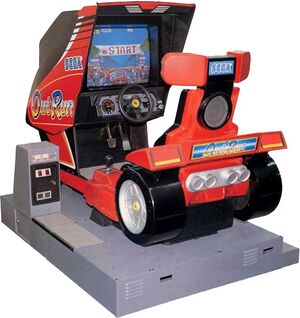Sega System series
From Sega Retro

The Sega System series stands as the first set of "consistent" arcade boards used at Sega, following an experimental period in the late 1970s and early 1980s. Aside from the naming convention adopted by Sega, the defining piece of architecture which links these boards together is the existence of an 8-bit Zilog Z80 chip. Earlier boards use this for the CPU, later ones demote it to handling sound. Sega System hardware primarily spans a period from 1983 to 1992, when it was succeeded by the Sega Model series.
Three "generations" of the Sega System series exist; the Sega System 1, Sega System 16 and later Sega System 32. Alongside these, variants of the hardware exist for dealing with more complex graphics. The "Super Scaler" series was used to create three-dimensional sprite/texture scaling graphics, including the Sega Hang-On hardware, Sega OutRun hardware, Sega X Board and Sega Y Board. Other variants include the Sega System 24 opting for high-resolution games, and relatively minor upgrades such as the Sega System 2 and Sega System 18. Budget systems such as the Sega System C and Sega System E were also released around this period, and share similarities with Sega's home consoles of the era (the Sega Mega Drive and Sega Master System, respectively).
Subdivisions
Ranges
- Super Scaler series (high-end)
- Sega Hang-On hardware (1985)
- Sega OutRun hardware (1986)
- Sega X Board (1987)
- Sega Y Board (1988)
- Sega System 32 (1990)
- Sega Titan Video (1994)
- Sega H1 Board (1995)
- Sega System series (mid-range)
- Sega System 1 (1983)
- Sega Appoooh hardware (1984)
- Sega System 2 (1985)
- Sega System 16 (1985)
- Sega System 24 (1988)
- Sega System 18 (1989)
- Console-based series (budget)
- Sega System E (1985)
- Mega-Tech System (1989)
- Sega System C (1989)
- Mega Play (199x)
Generations
- 8-Bit
- Sega System 1 (1983)
- Sega Appoooh hardware (1984)
- Sega System 2 (1985)
- Sega System E (1985)
- 16-Bit
- Sega Hang-On hardware (1985)
- Sega System 16 (1985)
- Sega OutRun hardware (1986)
- Sega X Board (1987)
- Sega System 24 (1988)
- Sega Y Board (1988)
- Mega-Tech System (1989)
- Sega System 18 (1989)
- Sega System C (1989)
- 32-Bit
- Sega System 32 (1990)
- Sega Titan Video (1994)
- Sega H1 Board (1995)
Subcategories
This category has the following 15 subcategories, out of 15 total.
Pages in category "Sega System series"
The following 18 pages are in this category, out of 18 total.